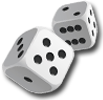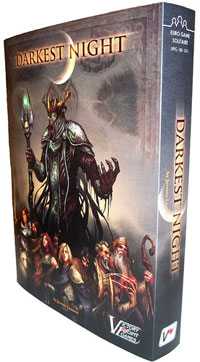



play board games
Board game reviews, strategy tips & session reports
Darkest Night Board Game Review
 Stats:
Stats:
No. of players: 1-4 (5 with variant options)
Amount of time to play: 150 min
Age requirements: 12+
Set-up time: 5-10 minutes
Darkest Night sets four heroes against an evil Necromancer that has taken over the land. Your group gathers at the monastery and must find holy relics to defeat your foe. He will not make this easy as his minions spread across the land. Can you persevere and win the day?
Darkest Night Rules Description:
Darkest Night is a cooperative game set in a fantasy world. There are nine playable characters with unique powers and abilities. You lose if the monastery ever has five blights on it. You can win by bringing three holy relics to the monastery or killing the Necromancer in combat.
The board starts with a blight in every location but the monastery. If you ever are told to place a blight on a location with four already present the blight enters at the monastery instead.
You start this game by selecting a hero. Each one comes with four possible starting powers or abilities. You choose three of these powers then shuffle the remaining one into your power deck. Additional powers may be obtained later.
Heroes have two stats: grace and secrecy. Grace is similar to health and must be spent if you are hit. If you ever have to spend a grace and don’t have one you die. High secrecy keeps the Necromancer unaware of you and some actions are powered by it.
The game uses six-sided dice and you default to rolling one. You need to meet or beat your target number on any die you roll. A couple power cards add 1 to a die but most just add more dice to your pool.
Each hero takes a turn and you determine the order. At the start of your turn you lose one secrecy if the Necromancer is present or if you hold a holy relic. If your secrecy is zero and you are present with the Necromancer he will attack you.
Next you draw an event card. These are usually bad and force you to defend yourself or elude a baddie. Once the event card is resolved you take your action. Available actions are Move, Hide, Pray, Search, get a holy relic, Attack or Activate a power. Move lets you go to an adjacent location and gain a secrecy. Some powers are exhausted (flipped over) after one use. Hide lets you refresh these powers and gain a secrecy. You may only pray in the monastery and may gain grace. Searching helps you find treasure (used to get more powers), keys and other useful items. What you find is based on drawing a map card. Three keys can be discarded to get a holy relic. If you Attack a blight in your area and match its might you remove it from the board. Some powers must be activated and thus use your action.
If at the end of your turn there are blights in your location you must deal with their effects. Some don’t allow you to use abilities and powers, while others you will have to defend against or elude in combat. Failure in this combat will cost you one point of grace while success does not remove the blight from the board.
After all the heroes have all gone the Necromancer has his turn. First the darkness increases by one. At higher levels the darkness can help him create more blights or even put blights directly on the monastery. Next you roll a die for him. If it is higher than a hero’s secrecy he moves to (or toward) that hero’s location. If you can find more than one hero than you decide which way he moves. If he is unable to detect any of the heroes the board shows you where to move based on his die roll. Now he creates a blight at his new location based on a map card draw.
In order to kill the Necromancer you need to roll a 7. That is pretty tough on a 6-sided die. Thankfully if you hold a holy relic it adds one to your highest die. He also will sacrifice blights to save himself. That means you’ll have to clear the locations of blights before you get a swing at him.
This goes on until one of the two win conditions are met or you lose.
Quick Review of Darkest Night:
Darkest Night is cooperative bard game with a ton of theme. It plays well solo and is fun with up to four. I did not try either of the five player variants as they did not seem to be as much fun. One adds another hero but throws off the game balance. The other variant lets someone be the Necromancer which would probably be boring for that person.
The components for this game are great. This game is part of Victory Points Games’ Gold Banner Products and that means higher quality chits. The counters, board and cards are much better quality and the art is fantastic. This game looks great on the table. The rules are well written and pretty easy to follow. The only thing about the new components I don’t like is that they are laser cut. I am not anti-laser it is that the process leaves soot behind on the edges of the counters. A napkin is provided to help you clean them up though. It is not a big deal but something you should know about.
The number of characters in the game is great. Having nine different hero types that play different, gain different powers and play differently together adds to the replay value of this game. I am not sure all the characters are equally useful though. Some help you search and some help you fight while others are more support characters. A couple players felt they did little to help earn a win and I think it mostly depended on the character they choose.
The different powers help make this game fun too. You spend much of the early game searching for keys and powers and seeing what powers you get to add to your hero is exciting.
The game play is typical for a cooperative board game and will remind people of Defenders of the Realm or Arkham Horror. Darkest Night is quicker and less complex than both of those and makes a great introduction to the cooperative game genre.
One qualm I have is that the game is not hard enough. There is some tension in this game but in many games we felt we had it won easily. This is compounded by certain heroes being better than others. The Scholar can get a +1 to a die roll and can win early with a good roll. Fortunately there is a variant to make the game harder. It requires you to start with two blights in each location. You also get a random hero and start with three random starting powers. This cranks up the difficulty and tension a bunch. I would always play with this variant unless teaching the game to newer gamers.
The other issue is that the strategy seems a bit repetitive. Search early game then lure the Necromancer to a location with only on or two blights. On the next couple of turns you just jump him and hope to get lucky enough to land a hit. You might have a scenario with a bunch of good searchers and try to get three holy relics, but that seems like a less used winning strategy. Again the random selection of heroes helps with this issue. One of the fun things is trying to figure out how to beat the Necromancer with the characters you have. When you select your hero and their starting powers randomly it adds to the necessity to adjust your tactics.
Darkest Night is a great introduction to cooperative board gaming. If you have a group that likes fantasy themed games and wants to try out a cooperative game, this is a good one to try. I have to say I like the game better with the variant as the added difficulty adds to the tension and fun. If you get the chance to try this you should. And if you are a fan of Victory Point Games you should look forward to more Gold Banner Products.
Score and synopsis: (Click here for an explanation of these review categories.)
Strategy 4 out of 6
Luck 5 out of 6
Player Interaction 5 out of 6
Replay Value 4 out of 6
Complexity 4 out of 6
Fun 5 out of 6
Overall 5 out of 6 (this might be just a 4 without the experienced variant)

Leave a Reply